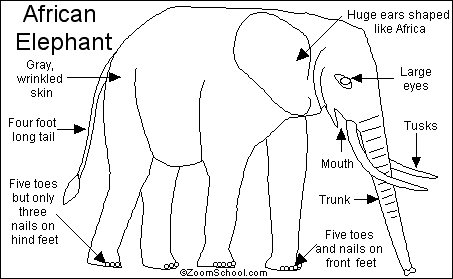The African Elephant is the largest living land animal (larger than the
Asian Elephant). These mammals have very strong social bonds and live in family groups headed by a female (called a
cow). Males (called
bulls) occasionally join the group. Elephants are excellent swimmers.
Elephants have few natural enemies except man, and they are in danger of extinction due to loss of habitat and poaching (they are killed for their ivory tusks).
Anatomy: African elephants average about 10 feet (3 m) tall at the shoulder, weighing roughly 6 tons (5,400 kg). Males are larger than females. Both males and females have
tusks (large, pointed ivory teeth). They have wrinkled, gray-brown skin that is almost h

airless.
Ears: African Elephants have large ears (up to 5 feet=1.5 m long) that are shaped like the continent of Africa. The ears not only hear well, but also help the elephant lose excess heat, as hot blood flows near the surface of the skin.
Trunk: Elephants breathe through two nostrils at the end of their trunk, which is an extension of the nose. The trunk is also used to get water and food. To get water, the elephant sucks water into the trunk, then curls the trunk towards the mouth and squirts the water into it. The trunk has two
prehensile (grasping) extensions at the tip, which it uses like a hand.
Diet: Elephants eat roots, grasses, leaves, fruit
